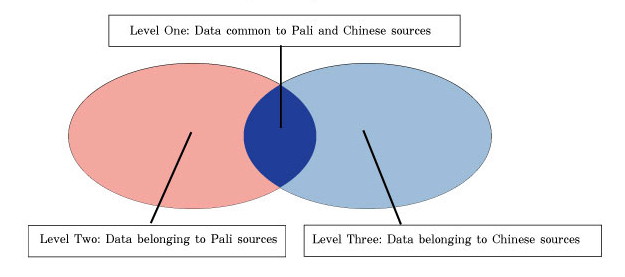Research
This project, based on the collection of source materials that appears below, uses a catalogue we have compiled of early Buddhist scriptures arranged chronologically to throw light on the Buddha's life and the history of the formation of the Saṃgha.
1. The collection of source materials looks to the early Buddhist scriptures as primary, or "A", documentation and to the works of commentary on them as secondary, or "B", documentation.
2. First and foremost we attempt to exclude all foregone conclusions from these documents and regard them in an all-encompassing way without any oversight, collecting from them data concerning people, place names, events (historical descriptions), and the contents of sutras. Our basic work has been to store and process this data by computer. The format on which this data collection has been done is described in Essay 1, Monograph 1, and it appears as Document 1.
3. In general, it is usual for the data collected from the early Buddhist scriptures to be measured for reliability according to how old it is (for example, verse sections are considered to be older than prose sections, but it is difficult to judge whether this assumption is correct or not). In this research, we give equal weight to the materials recorded in all the early Buddhist scriptures. Consequently, the essays that have already been written have in principle taken the form of beginning by introducing all the data associated with the topic of the essay as either A documentation or B documentation. These are then analysed to assess which should be utilized.
4. The fundamental criterion for assessing which data from the A documentation to utilize is that common to all documents, especially the Chinese and Pāli. What we term "data" here is, speaking clearly, episodes that describe the Buddha's life and the formative history of the Saṃgha.
5. When there are contradictions between the Pāli and Chinese data, the Pāli data is given more weight. This is because our prime motivation is not to cast light on historical fact so much as to understand what image the compilers of the scriptures had about the Buddha's life and the formative history of the Saṃgha. Whereas the early scriptures translated into Chinese were those transmitted by various sects, the Pāli scriptures belonged to one sect, the Theravadins. Thus they are more likely to present a unified image.
6. Based on the above thinking, we have tried to divide each episode into three levels (see diagram). In principle, we place greater weight on data from the higher level.

7. Data based on commentaries may be said to belong to Level Four. Of course there can be no problem about using it positively when there are no contradictions with data in the early scriptures. Nevertheless, there are a considerable number of contradictions even among the data in these scriptures, and, it must be said, there are such cases among Level One data as well. In such situations, we consult the commentaries to assess which can give the more logical explanation and so which should be utilized. However, there is a danger of using data arbitrarily when assessing sources according to logic. As research continues and many facts become clearer, I think it is necessary to review the data again from broader and more overall connections.
8. Even if we are able to muster the data in the early scriptures fully, when problems arise that cannot be clarified, then it is possible to utilize data from the commentaries that can be interpreted logically in order to plug the gap in the data. Needless to say, of course, careful study is necessary.
9. Even when we use all the data freely, there are times when we have to ask how we are able to fill the remaining gaps. It may be the academic stance to admit defeat when no more data is available, but this would mean we will never be able to form an image of the Buddha's life. We must of course be able to distinguish clearly between empirical research and conjecture, but I think it is essential that at a certain stage we are able to make broad inferences as working hypotheses. Of course, these too, as research continues, will be subject to review within the overall, broader context.
It is based on this use of documentary material that we hope to attain our research objectives.


